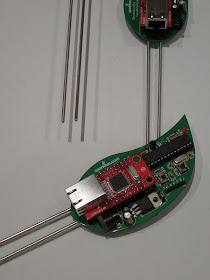Talk TO Me:
Design and Communication
between People and Objects
Design and Communication
between People and Objects
MoMA
Someone recently told me that nothing that happens digitally would surprise them. This might be true, but the Talk to Me exhibition at MoMA will definitely blow your mind. You have to go back a couple of times to take it all in. I decided to focus on the pieces that focus on nature - as we don't know it! BOTANICALLS (photograpah above) it might look like a guitar, but no.
Robert Faludi
Kate Hartman
Kati London
Rebecca Bray
"Botanicalls gives voice to our voiceless everyday companions: house plants. Mositure sensors in a plant's soil trigger messages that are sent to a human caretaker over a wireless network. The messages are broacdcast via Twitter or read aloud by a recorded human voice over the telephone: the plants are polite enough to send both distress calls and notes of thanks.
Botanicalls enables just one form of interspecies communication, but its fresh use of sensor technology has a wide range of potential applications." MoMA text
TREE LISTENING
Alex Metcalf, Royal College of Art, UKAt the MoMA show the headphones are below this photograph. You put them on and listen to the tree.
"Metcalf's Tree Listening installations in various locations around the United Kingdom reveal what happens inside a tree, where water and nutrients ascend from roots to leaves through a complex hydraulic system of xylem tubes. To create a sensory glimpse into this system, Metcalf designed a solar-powered listening device that is place on a tree trunk, linked to an amplifier, and connected to a series of headphones that hang from the branches. Through the headphones, passerby can listen to a tree's inner workings....
Tree bark is figuratively stripped away, revealing a unique soundscape." MoMa text
Hello World
Bernhard Hopfengartner
"Hello World! is a giant Semacode mowed into a wheat field near limenau, in Germany's Thuringia region. The code is formed by a pattern of light (cut wheat plants mixed with dirt) and dark (mature wheat plants) squares, eighteen across and eighteen down, that when decoded reads "Hello World!" in keeping iwth the tradition of christening any new coding experiment by programming it to produce this cheerful declaration.
Bernhard Hopfengartner
"Hello World! is a giant Semacode mowed into a wheat field near limenau, in Germany's Thuringia region. The code is formed by a pattern of light (cut wheat plants mixed with dirt) and dark (mature wheat plants) squares, eighteen across and eighteen down, that when decoded reads "Hello World!" in keeping iwth the tradition of christening any new coding experiment by programming it to produce this cheerful declaration.
The installation, now captured in Google's Earth's global database of images, marries high-tech medium while also making reference to crop circles and the ancient language of runes. The human need for expression continues at a global, even planetary scale." MoMA text
As part of the exhibition there is a pyramid, like the food pyramid.
This graph represents "Distractability."
At the top of the pyramid DARK NIGHT, DIGITAL PAIN.
Next in line = IPhone and Mobile Phone call.
After that = email, twitter, text message
etc., etc., etc.
I recently experienced (briefly) digitally pain. I now understand, how addiction, can sneak up on you and withdrawal is painful at first. Then you realize the sun is still shining, it's a good day for a walk!
As part of the exhibition there is a pyramid, like the food pyramid.
This graph represents "Distractability."
At the top of the pyramid DARK NIGHT, DIGITAL PAIN.
Next in line = IPhone and Mobile Phone call.
After that = email, twitter, text message
etc., etc., etc.
I recently experienced (briefly) digitally pain. I now understand, how addiction, can sneak up on you and withdrawal is painful at first. Then you realize the sun is still shining, it's a good day for a walk!




No comments:
Post a Comment